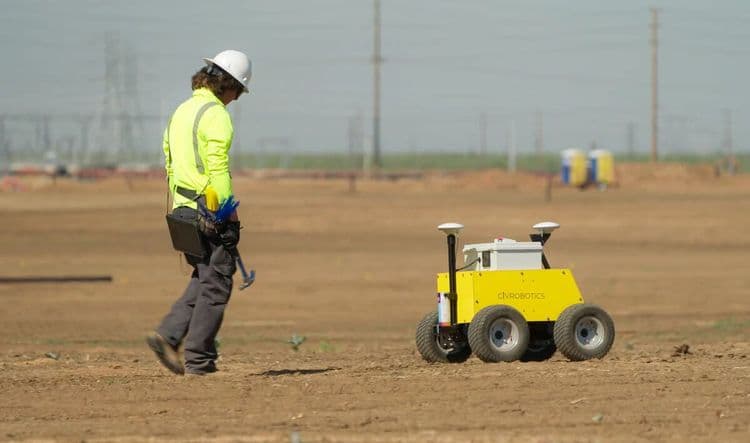
State and regional solar goals have soared as renewable energy becomes a high priority. As of this year, 14 states have goals for 100% carbon- or emissions-free electricity. But meeting these objectives isn’t an easy task. While other hurdles lie in solar’s path, the uncertainty of labor is one of the greatest threats to the industry’s success. This mounting pressure alongside waning resources calls for new tech to help stay on track.
A Laborious Conundrum
Many of solar’s unique challenges are due to project locations. Sites are typically far from metropolitan areas, often spread across hundreds or thousands of acres. In contrast with decade-long highway or rail projects, solar projects are short and high-intensity. Often completed in mere months, they require a high number of personnel (around 1.5 full-time equivalent workers per megawatt) for high-intensity projects.
Staffing these sites is a major obstacle; local talent is sparse, and most workers migrate from site to site. This system is unreliable and frustrating for both travel-weary employees and perpetually recruiting employers. It’s no surprise that 44% of solar industry employers reported that it was “very difficult” to find qualified applicants.
Because of labor’s transient nature, there are often mismatches between workers and the jobs they’re on site to perform. “Close enough” is sometimes the mantra when hiring for a specific role. A newly-hired pile driver might have experience on a different machine and take time to reach normal efficiency, while another may know the machine and have double the output from day one. It isn’t the workers’ fault, of course; there simply aren’t enough of them to go around.
A Helping (Robotic) Hand
Robotics have long been a fixture on the manufacturing floor, but it’s increasingly common on solar projects. Robots excel at straightforward, repetitive tasks, which abound in solar construction.
Drones survey the land, and then heavy machinery using guidance systems can clear the land based on these 3D model designs. Surveying bots then step in to mark the layout with pinpoint accuracy for pile driving. Several robotics companies are trying to automate the installation of solar panels using UGVs with robotic arms and humanoids. And during the whole process, quality control drones with an eagle-eye view ensure that everything is perfect: no spot-checking where mistakes can fall through the cracks.
Many of these robots are designed to operate in rugged terrain and difficult weather conditions. Drones have even allowed solar contractors to build solar infrastructure in previously inaccessible regions of Asia by delivering panels on terraces. Robotics not only supercharge construction but also enables it to exist where it was not possible before.
In an industry facing labor shortages, these technologies are more than just time-savers. When bots take on repetitive grunt work, skilled workers are freed up to focus on more complex jobs that require human expertise.
Robot Roadblocks and Resistance
Change can be hard, especially in an industry where a “that’s how we’ve always done it” mindset is all too common. Accepting new solutions can take convincing, especially for those who don’t feel comfortable with tech. Mindful training and gradual implementation can ease that discomfort. Still, not everyone will be eager to accept robotics. This hesitation is a reality on the modern jobsite and must be weighed against the benefits.
While some bots can seamlessly integrate into existing workflows, others require planning adjustments that can be an upfront hassle. Look for providers that prioritize easy integration and offer training and support to make adoption as painless as possible.
The widespread fear of AI and bots taking jobs may also cause some to hesitate to bring robotics to the field. However, in an area plagued with labor shortages and high demand, robots are generally a welcome aid. This doesn’t mean robots need to take over every step of construction, but they should be thoughtfully implemented in the areas of most impact, depending on project demands and leadership insights.
Tactics For Trailblazers
Implementing robots isn’t as easy as letting them loose and sitting back. Most bots require human teammates who are as committed to efficiency as they are to getting the job done. Let’s say a traditional surveying team can mark 300 points a day. A bot is brought in that is estimated to mark over 1,000 per day. However, with the bot, only 600 points are being marked. This is an improvement, but not as significant as expected.
The problem? The crew isn’t keeping up and may work under the impression that this increased output means they can step back. Long breaks, poor coordination, late starts and other issues slow down the robots’ work. Wasted time is compounded when super-efficient tech is in play. When implementing, ensure your team is 100% on board to cooperate with their speedy counterparts, or robotics won’t be as impactful.
Here Comes The Sun
Robotics not only impact today’s solar worksites. Robots play a role in shaping how the industry evolves. A few years ago, we would avoid installing solar on hard soil. Now, racking systems, piling alternatives and bot interventions have made projects like this possible. More massive changes are coming, including fully autonomous machines and advanced systems to work even better in inaccessible areas. The worksite won’t look like it does now, and we need to be ready to adapt.
The workflow will continue these dramatic evolutions. Prefab is gaining traction in the solar space and could be significantly improved by delivery and transportation bots. As installations grow in scale, project plans need to evolve, and robots that can effectively manage large, complex areas will be critical.
Solar demand is only set to increase, and the need for intelligent automation will only increase. It’s time to embrace our techy companions and bring solar into a better era. The forecast is sunny with a chance of bots. Are you ready?

